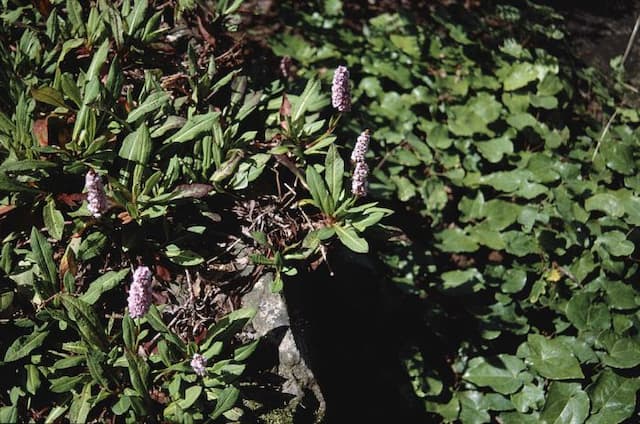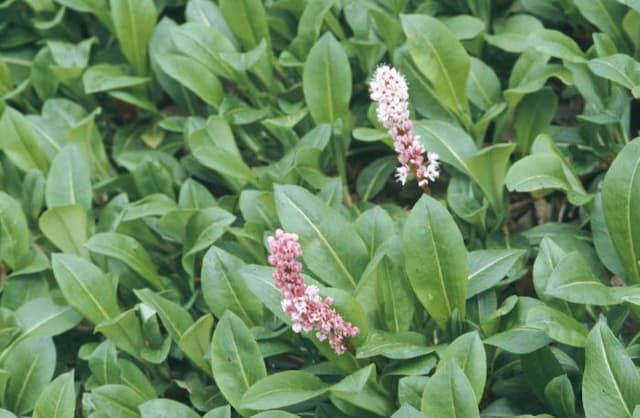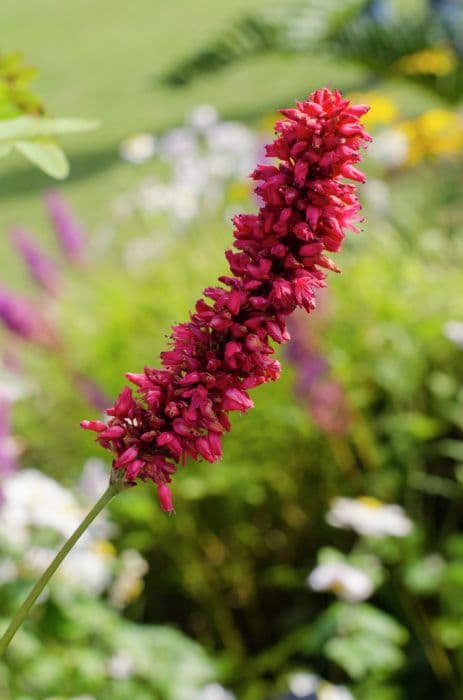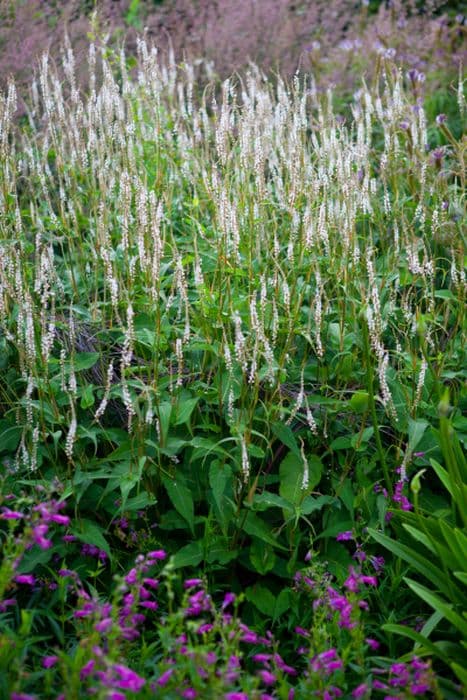Turkish rhubarb Rheum palmatum

ABOUT
Rheum palmatum, commonly known as Chinese rhubarb, is a perennial herb that is notable for its bold and striking appearance. This plant features large, deeply lobed leaves which bear a resemblance to the palm of a hand, hence the "palmatum" part of its name. The leaves are often a rich green hue, but they may start off with a reddish or purple tinge when young before maturing to the darker color. During the blooming period, the Chinese rhubarb sends up dramatic flower stalks that carry tiny flowers arranged closely together in a long, dense cluster. These flowers can range from white to pink or red, creating an eye-catching display. The flowers eventually give way to winged fruits, which are visually interesting as well. The stems of Chinese rhubarb are thick and robust, supporting the hefty leaves and the substantial flower spikes. They typically exhibit a reddish or green color, blending harmoniously with the foliage and the floral elements of the plant. The overall impression of Chinese rhubarb is one of a lush, architectural plant with distinctive features that make it a stand-out in any garden setting where it is cultivated. Despite being a practical plant in some cultures, mainly used for its root in traditional medicine, its ornamental values are undeniable, thanks to its large leaves and prominent flowers.
About this plant
 Names
NamesFamily
Polygonaceae.
Synonyms
Turkish Rhubarb, Chinese Rhubarb, Ornamental Rhubarb, East Indian Rhubarb, Turkey Rhubarb.
Common names
Palmatirheum officinale, Rheum qinlingense, Rheum officinale, Rheum palmatum var. tanguticum, Rheum tanguticum, Rheum webbianum.
 Characteristics
CharacteristicsLife cycle
Perennials
Foliage type
Deciduous
Color of leaves
Green
Flower color
Red
Height
6 feet (1.8 meters)
Spread
3 feet (0.9 meters)
Plant type
Herb
Hardiness zones
5
Native area
China
Benefits
 General Benefits
General Benefits- Decorative foliage - Rheum palmatum, commonly known as Chinese rhubarb, has large, ornate leaves that can add aesthetic appeal to gardens.
- Natural dye - The roots of the plant have historically been used to produce a natural red dye.
- Culinary use - While not as commonly used as garden rhubarb, the petioles (leaf stalks) can be used in similar culinary applications when properly prepared to avoid high levels of oxalic acid.
- Companion planting - Chinese rhubarb can be beneficial in the garden by deterring certain pests when used in companion planting strategies.
- Soil improvement - As a deep-rooted plant, it can help in breaking up the soil and improving soil structure over time.
- Biodiversity - Planting Rheum palmatum can support biodiversity in the garden by providing habitat and resources for various insects and other wildlife.
- Erosion control - The robust root system can help to stabilize soil and reduce erosion on slopes or where soil conservation is necessary.
 Medical Properties
Medical Properties- Anti-inflammatory: Rheum palmatum has properties that may help reduce inflammation in the body.
- Laxative effect: The root of this plant is known for its strong laxative properties, helping to relieve constipation.
- Astringent: It also has astringent effects, which can be beneficial for treating various skin conditions and for wound healing.
- Antimicrobial: Components in Rheum palmatum may exert antimicrobial effects against certain pathogens.
- Antioxidant: This plant contains compounds with antioxidant properties that may help protect cells from oxidative damage.
- Liver protection: There is some evidence that suggests Rheum palmatum may have hepatoprotective effects, helping to maintain liver health.
- Cholesterol-lowering: Some studies imply that it might help in managing cholesterol levels.
- Gastrointestinal health: Besides its laxative action, it is sometimes used to promote overall digestive system health.
- Anti-tumor properties: There is preliminary research indicating that Rheum palmatum might have anti-tumor effects.
 Air-purifying Qualities
Air-purifying QualitiesThis plant is not specifically known for air purifying qualities.
 Other Uses
Other Uses- Rheum palmatum, commonly known as Turkish rhubarb, has been used historically to create natural dyes for textiles due to its rich pigment content.
- The large leaves of Turkish rhubarb can serve as a protective cover for fragile plants, shielding them from light frosts or intense sunlight.
- In some regions, Turkish rhubarb stems are used to create a sour-flavored syrup for use in culinary applications or as a base for beverages.
- Because of its striking appearance, Turkish rhubarb can be planted as an ornamental garden plant, adding architectural interest to landscape designs.
- The fibrous stalks of Turkish rhubarb have been experimented with as a component in making paper or fabric in sustainable manufacturing practices.
- Composted leaves and waste from Turkish rhubarb can enrich garden soil by contributing nutrients and improving soil structure.
- In the creation of natural insect repellents, extracts from Turkish rhubarb have been utilized due to certain compounds that are undesirable to insects.
- The plant has been featured in artistic representations, such as botanical illustrations, due to its unique and visually appealing structure.
- Some cultures have incorporated elements of Turkish rhubarb into traditional costumes or ceremonial garments, often through dyeing processes.
- With its deep roots, Turkish rhubarb can be used in erosion control applications, helping to stabilize soil in sloped areas of gardens or landscapes.
Interesting Facts
 Feng Shui
Feng ShuiThe Chinese rhubarb is not used in Feng Shui practice.
 Zodiac Sign Compitability
Zodiac Sign CompitabilityThe Chinese rhubarb is not used in astrology practice.
 Plant Symbolism
Plant Symbolism- Healing: Rheum palmatum, commonly known as Chinese rhubarb, has been used in traditional medicine for its healing properties, particularly for digestive issues.
- Cleansing: The plant is thought to symbolize internal cleansing due to its purgative effects when used as an herbal remedy.
- Protection: As a medicinal plant, Chinese rhubarb is often associated with protective qualities, safeguarding against illness and diseases.
- Longevity: Given its use in various health treatments, it represents the desire for a long and healthy life.
 Water
WaterThe Chinese rhubarb needs consistently moist soil, especially during its growing season. It is essential to water the plant deeply once a week, providing about 1 to 1.5 gallons of water each time, depending on the weather conditions and soil drainage. During hot, dry periods, additional watering may be necessary to maintain soil moisture. However, it is crucial to avoid waterlogging as this can lead to root rot. In winter, reduce watering to match the plant's dormancy and lower evaporation rates, checking the soil before adding water to ensure it has partly dried out.
 Light
LightChinese rhubarb thrives in both full sun and partial shade conditions. It prefers a spot that gets at least four to six hours of direct sunlight per day. A location with morning sunlight and afternoon shade is ideal, as intense afternoon sun can sometimes be too harsh, especially in hotter climates.
 Temperature
TemperatureChinese rhubarb grows best in temperatures between 50°F and 75°F, which mimics its native habitat's cool conditions. It can survive minimum temperatures down to around -30°F, making it hardy in cold climates. The plant can also withstand brief periods of heat above the 75°F mark but prolonged exposure to high temperatures may stress the plant.
 Pruning
PruningPruning Chinese rhubarb is mainly done to remove spent flower stalks, which encourages the plant to focus its energy on foliage growth. Prune the flower stalks back to the ground level after they have bloomed, typically in late spring or early summer. It is also a good practice to remove any damaged or diseased leaves as they appear to maintain plant health.
 Cleaning
CleaningAs needed
 Soil
SoilTurkish rhubarb thrives in a soil mix that is well-draining and rich in organic matter. A mix of garden soil, compost, and perlite or sand in equal parts creates an optimal environment. This plant prefers a soil pH ranging from 6.0 to 7.0.
 Repotting
RepottingTurkish rhubarb should be repotted every 2-3 years to replenish the soil and give the roots more room to grow. It is best to repot in the spring just before the growing season begins.
 Humidity & Misting
Humidity & MistingTurkish rhubarb prefers moderate humidity levels; however, it is fairly adaptable and can tolerate the humidity levels found in most temperate climates well.
 Suitable locations
Suitable locationsIndoor
Place Turkish rhubarb in bright, indirect light indoors.
Outdoor
Plant Turkish rhubarb in partial shade with rich soil.
Hardiness zone
4-8 USDA
 Life cycle
Life cycleRheum palmatum, commonly known as Chinese rhubarb, generally starts its life as a seed which, when conditions are favorable, germinates and develops into a seedling. The seedling grows into a juvenile plant, developing a deep taproot and large leaves with a distinctive palmate shape. As the plant matures, it forms a robust, leafy perennial with a thick, woody rhizome at its base. Chinese rhubarb typically reaches maturity in 2-3 years, during which it can start to produce stalks of small, white to reddish flowers that rise above the foliage in dramatic clusters if environmental conditions are right. After flowering, seeds are produced and dispersed, completing the reproductive cycle. Chinese rhubarb then enters a dormant phase during the winter months, resuming growth in the spring.
 Propogation
PropogationPropogation time
Spring-Early Summer
Rheum palmatum, commonly known as Chinese rhubarb, is typically propagated by dividing the roots. The best time for dividing and propagating this perennial plant is in the early spring or fall when the plant is dormant. To propagate by division, carefully lift the plant from the ground and use a sharp knife or spade to slice through the crown, making sure each section has at least one bud or eye. Plant the divisions promptly, spacing them about 36 inches (about 91 cm) apart, ensuring the buds are just below the soil surface. Water the newly planted divisions thoroughly to help establish them. This method of vegetative propagation maintains the characteristics of the parent plant and allows for quicker establishment in the garden compared to seed propagation.






![Red bistort [Taurus]](/_next/image?url=https%3A%2F%2Fplants-admin.emdemapps.com%2Fimages%2Fplants%2F%2Fimages%2F604b548be7841.png&w=640&q=75)


